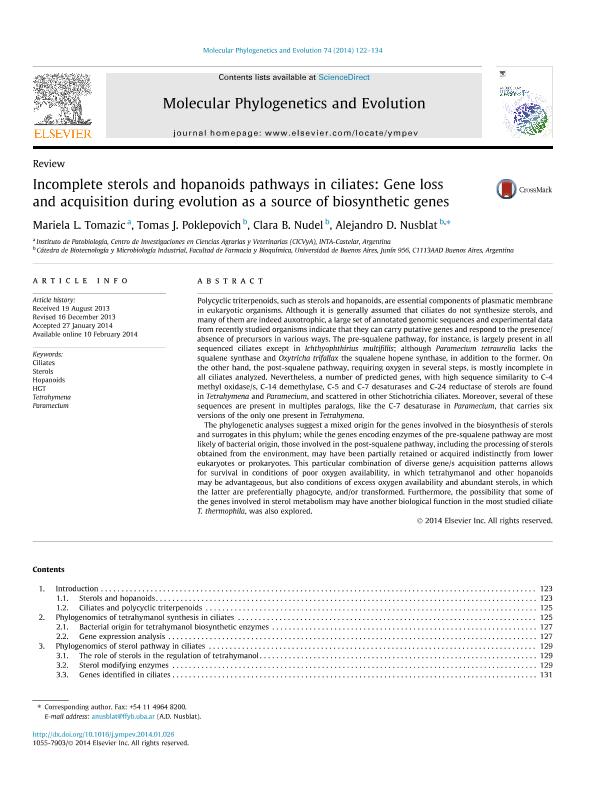Artículo
Incomplete sterols and hopanoids pathways in ciliates: gene loss and acquisition during evolution as a source of biosynthetic genes
Tomazic, Mariela Luján ; Poklépovich Caride, Tomás Javier
; Poklépovich Caride, Tomás Javier ; Nudel, Berta Clara
; Nudel, Berta Clara ; Nusblat, Alejandro David
; Nusblat, Alejandro David
 ; Poklépovich Caride, Tomás Javier
; Poklépovich Caride, Tomás Javier ; Nudel, Berta Clara
; Nudel, Berta Clara ; Nusblat, Alejandro David
; Nusblat, Alejandro David
Fecha de publicación:
01/2014
Editorial:
Elsevier Inc
Revista:
Molecular Phylogenetics and Evolution
ISSN:
1055-7903
Idioma:
Inglés
Tipo de recurso:
Artículo publicado
Clasificación temática:
Resumen
Polycyclic triterpenoids, such as sterols and hopanoids, are essential components of plasmatic membrane in eukaryotic organisms. Although it is generally assumed that ciliates do not synthesize sterols, and many of them are indeed auxotrophic, a large set of annotated genomic sequences and experimental data from recently studied organisms indicate that they can carry putative genes and respond to the presence/absence of precursors in various ways. The pre-squalene pathway, for instance, is largely present in all sequenced ciliates except in Ichthyophthirius multifiliis; although Paramecium tetraurelia lacks the squalene synthase and Oxytricha trifallax the squalene hopene synthase, in addition to the former. On the other hand, the post-squalene pathway, requiring oxygen in several steps, is mostly incomplete in all ciliates analyzed. Nevertheless, a number of predicted genes, with high sequence similarity to C-4 methyl oxidase/s, C-14 demethylase, C-5 and C-7 desaturases and C-24 reductase of sterols are found in Tetrahymena and Paramecium, and scattered in other Stichotrichia ciliates. Moreover, several of these sequences are present in multiples paralogs, like the C-7 desaturase in Paramecium, that carries six versions of the only one present in Tetrahymena. The phylogenetic analyses suggest a mixed origin for the genes involved in the biosynthesis of sterols and surrogates in this phylum; while the genes encoding enzymes of the pre-squalene pathway are most likely of bacterial origin, those involved in the post-squalene pathway, including the processing of sterols obtained from the environment, may have been partially retained or acquired indistinctly from lower eukaryotes or prokaryotes. This particular combination of diverse gene/s acquisition patterns allows for survival in conditions of poor oxygen availability, in which tetrahymanol and other hopanoids may be advantageous, but also conditions of excess oxygen availability and abundant sterols, in which the latter are preferentially phagocyte, and/or transformed. Furthermore, the possibility that some of the genes involved in sterol metabolism may have another biological function in the most studied ciliate T. thermophila, was also explored.
Palabras clave:
Ciliates
,
Hopanoids
,
Sterols
,
Hgt
,
Paramecium
,
Tetrahymena
Archivos asociados
Licencia
Identificadores
Colecciones
Articulos(OCA HOUSSAY)
Articulos de OFICINA DE COORDINACION ADMINISTRATIVA HOUSSAY
Articulos de OFICINA DE COORDINACION ADMINISTRATIVA HOUSSAY
Citación
Tomazic, Mariela Luján; Poklépovich Caride, Tomás Javier; Nudel, Berta Clara; Nusblat, Alejandro David; Incomplete sterols and hopanoids pathways in ciliates: gene loss and acquisition during evolution as a source of biosynthetic genes; Elsevier Inc; Molecular Phylogenetics and Evolution; 74; 1-2014; 122-134
Compartir
Altmétricas



